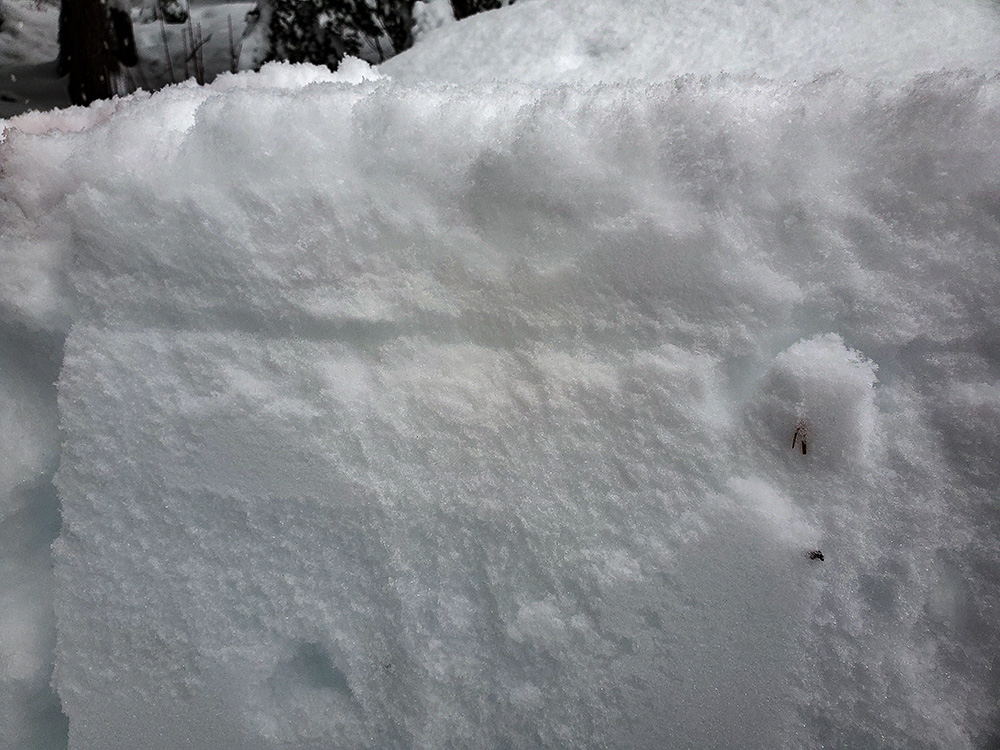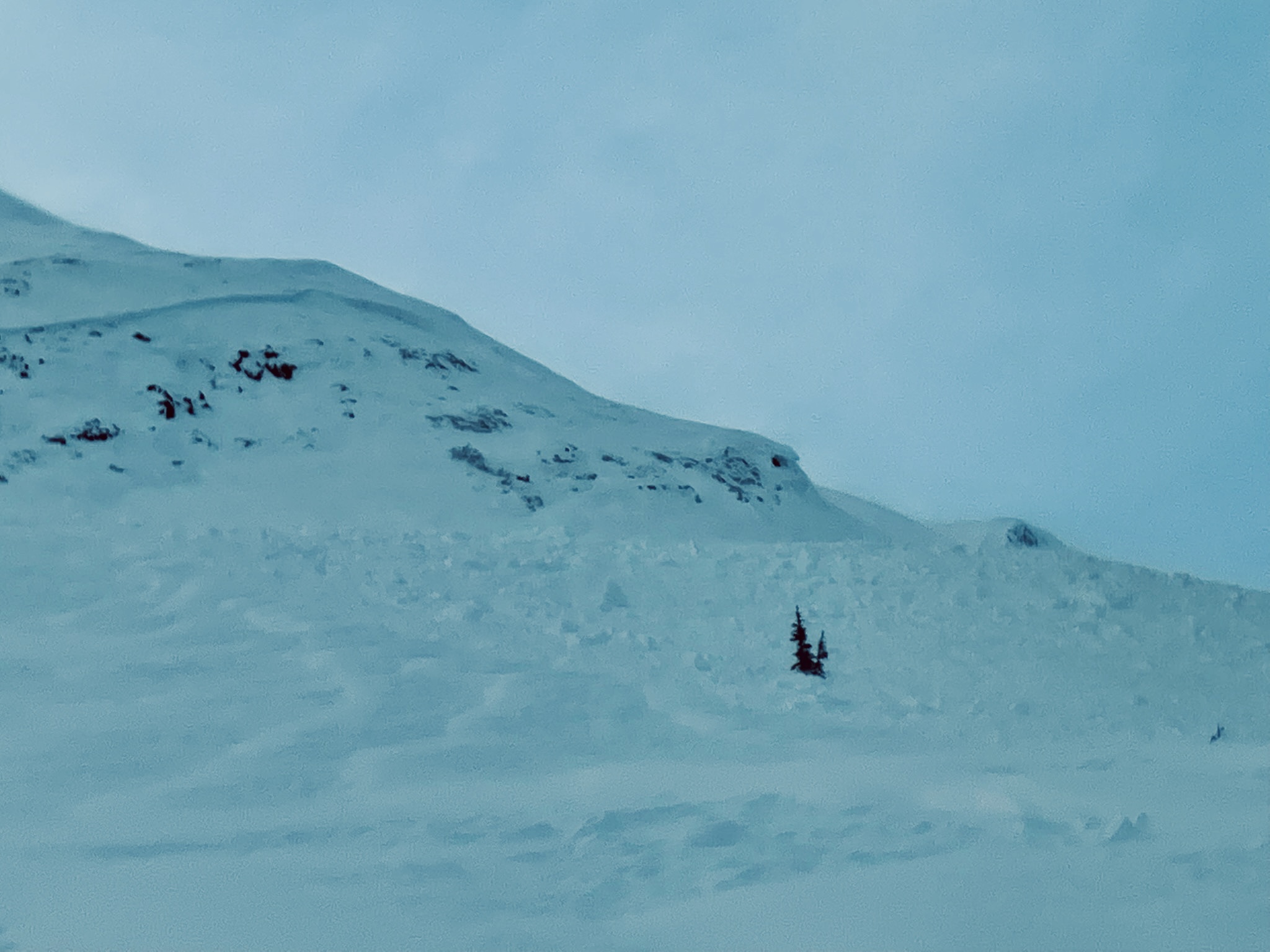Haines Avalanche Center
Above 2,500ftHigh
1,500 to 2,500ftHigh
Below 1,500ftHigh
Degrees of Avalanche Danger
Avalanche Problems
Problem 1
Aspect: All aspects and elevations
Bottom Line: Very heavy snowfall rates are expected today, with accumulations approaching 24″ by tonight. NW winds will be whipping around the new snow, and temperatures will be warming up drastically. All the red flags are present for a large natural avalanche cycle over the next day or two.
Travel Advice: Avoid all avalanche terrain! If you head out, stick to the trees and watch out for terrain traps where even small slides could pile up to be quite deep. Stay out of avalanche runout zones along valley bottoms.
Avalanches will be likely within the new snow, and failing on the new/old snow interface. Wind loaded areas could accumulate enough critical loading to trigger deep persistent weak layers, which could cause wide propagation and very large avalanches that run full-path.
Likelihood:
- Almost Certain
- Very Likely
- Likely
- Possible
- Unlikely
Size:
- Historic
- Very Large
- Large
- Small
Trend
- Increasing
- Steady
- Decreasing
Problem 2
Aspect: Mainly on wind-protected and wind loaded slopes, most likely beneath terrain features on S, SE, and E aspects
Elevation: All elevations, mainly at and above treeline.
Travel advice: Consider any possible slopes harboring buried surface hoar, or other weak snow as guilty until proven innocent. Always use safe travel techniques such as only exposing one person at a time both on the way up and down. Identify and avoid thin areas where weak layers are more likely to trigger a slide from. Group up in safe zones that are out of harms way. Have good communication, including radios and a set plan in case of an emergency. Be practiced at companion rescue..
- Surface hoar from Dec 18th may have been preserved in wind-protected areas. It is now buried by about a foot of snow.
- Recent observations from Old Faithful found a thin crust with weak snow down 60-70cm near 3,200′ and below
- This bathtub ring effect, from lower-elevations to mid-elevation, where freezing levels are more likely to cause crusts and weak layers – should be carefully evaluated.
- Weaker snow (buried facets) forming between wind slabs in the top of the pack
It is still possible that any surface avalanches could step down to deeper weak layers, the October rain crust, or even the ground in alpine areas.

Buried surface hoar layer (thin grey line) in an opening below treeline in the Transitional zone. This layer is now about 1-3ft deep. It exists in isolated wind protected areas.
Likelihood:
- Almost Certain
- Very Likely
- Likely
- Possible
- Unlikely
Size:
- Historic
- Very Large
- Large
- Small
Trend
- Increasing
- Steady
- Decreasing
Avalanche Activity
This natural avalanche occurred on Dec 12th on Old Faithful during a wind event. It ran on a cross-loaded NE aspect at 3200ft, running on the October rain crust. It shows that given a heavy new load, this persistent weak layer can activate and cause a large avalanche.

Weather
Forecast:
A moist and dynamic storm has arrived, with very heavy snowfall rates expected Sunday. We can expect 18-24″ of new snow by Sunday night. Snowfall will then continue through Monday with several additional inches likely. Finally, a changeover to rain will probably hold off until Monday night. Temperatures will be rising throughout the event, but north winds may hold out longer than expected and prevent a changeover to rain. The timing of this changeover is the most uncertain part of the forecast.
Seasonal Summary:
- Very strong NW winds and arctic temperatures blasted the area the first week of January
- Jan 1st: New snow (20″ in Lutak, 7″ Transitional zone) buried any preserved surface hoar.
- Moderate NW winds hit exposed slopes Dec 19-20th
- Surface hoar formed on all aspects and elevations Dec 17-18th
- December brought in about 2-5 feet of snowfall (highest in Lutak zone), and a few strong NW wind events
- November brought consistent heavy snowfalls, cold weather, and SE winds
- October brought heavy snow in the alpine, followed by a few rain/sun crusts
| Snow Depth [in] | Last 24-hr Snow/SWE [in] | Last 3-days Snow/SWE [in] | Today’s Freezing Level [ft] | Today’s Winds | Next 24-hr Snow/SWE | |
| Mount Ripinsky @ treeline ** | 80″* | 4″ / 0.15* | 4″ / 0.15* | 0′ | mod, NW | 20″ / 1.50* |
| Flower Mountain @ treeline | 47″ | 3″ / 0.10 | 3″ / 0.10 | 0′ | mod, NW | 20″ / 1.50* |
| Chilkat Pass @ 3,100ft | 16″ | 2″ / 0.10 | 2″ / 0.10 | 0′ | mod,NW | 14″ / 0.75* |
( *star means meteorological estimate )
** The Ripinsky weather station is in need of repair, and will likely be down until Summer.
Additional Information
Ride rescue ready. Be prepared for an emergency. Prevent hypothermia. Carry bear spray. Winter is a high consequence environment.
Become a sustaining Haines Avalanche Center Member by clicking the poster or visiting dev.alaskasnow.org/joinHAC. Support local forecasts, observations, education and weather stations. Join a community of winter recreationalists. Benefit from collective knowledge and skills. Help keep your friends and family safe in the backcountry. Get a free limited edition mountain buff, or neck gaiter with a $50 membership (first 20 members!).
Practice like you play. Make sure all your rescue gear is fully functional and your beacon has NEW batteries. Make sure 1) everyone in the group has a functioning beacon, shovel and probe 2) knows how to use them and 3) has trained in companion rescue in the last year. Keep your skills fresh. If you head into the hills, watch out for red flag avalanche conditions, natural avalanches, whoomphing or collapsing, and shooting cracks.
Education Video Links:
- AIARE
- How to Practice Avalanche Rescue Snowmobile Edition: https://youtu.be/2ML499MMDfM
- AK Sled Shed Motorized Learning:
- Intro: https://youtu.be/aoagKHfGkxs
- Personal Electronics in Avalanche Terrain: https://youtu.be/2Vz9S0OEyFk
- Snowmobile Macgyver Tool Kit: https://youtu.be/4WBNu_t6Bbk
- Head and Face Protection: https://youtu.be/jIzW89wOyZI
- Pre-season prep: https://youtu.be/zJmrb8cZlR4
- My Transceiver: https://youtu.be/yblaDWP7Jf8
- BCA Avalanche Safety for Snowmobilers
- How to Fix Common Snowmobile Problems in the Field: https://youtu.be/g9fiTxEvuFk
- Sleducation: Avalanche Safety for Snowmobilers: https://youtu.be/EWFOd_9DYb8
- Intro to Avalanche Transceivers for Snowmobilers: https://youtu.be/6ZLSBmsceog
- Avalanche Transceiver Trailhead Test for Snowmobilers: https://youtu.be/rWoXbadFBsY
- Avalanche Transceiver Searching Use Snowmobiles: https://youtu.be/w1ucyI6LMXM
- BCA Avalanche Rescue Series
- Beacon Search 101: https://youtu.be/nnHXLVA2FcE
- Avalanche Probing 101: https://youtu.be/-0_yDN5Drzw
- Avalanche Shoveling 101: https://youtu.be/dGQg9o3vAkM
- Organizing a Backcountry Rescue: https://youtu.be/gywtmukgt8s
- Post Avalanche Patient Care: https://youtu.be/9FyIeUy4wpQ
- Backcountry Evacuation: https://youtu.be/WPF-dciefL8
- Complex Multiple Burials Backup Techniques: https://youtu.be/pB6AfY2KyYo
- National Avalanche Center
- Avalanche Problems Explained: https://youtu.be/DkbnT_9-cHU
- Intro to North American Avalanche Danger Scale: https://youtu.be/r_-KpOu7tbA
Announcements
Very heavy snowfall rates are expected today, with accumulations approaching 24″ by tonight. All the red flags are present for a large natural avalanche cycle over the next day or two. Some avalanches could be very large and run full-path. Avoid all avalanche terrain including lower runout zones at valley bottoms. When temperatures warm up Monday evening-Tuesday, dangerous roof avalanches are likely.


